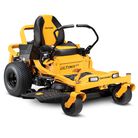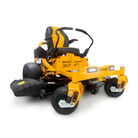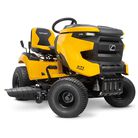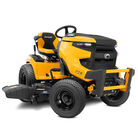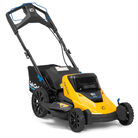1. What should I consider before choosing a lawn mower?
A lawn mower is a big investment, but it should be an exciting one because every yard needs a reliable lawn mower to keep it looking pristine. There are a lot of factors to consider, and Cub Cadet® is here to provide some guidance. Learn about all the different types, specifications, and features. But before you dive in, consider the following:
Yard size: Matching your lawn mower to your yard size is probably the most important consideration. If your yard is less than an acre, a walk-behind mower will do just fine, but if you live on a large property spanning multiple acres, you can skip right to riding lawn mowers with powerful engines and big decks.
Time spent mowing: When considered together, yard size and the time you want to spend mowing will really help you narrow down your lawn mower choices. Riding lawn mowers are traditionally recommended for larger properties. However, if you have a smaller yard but want to significantly reduce your mowing time, a rider might be your best option. If your yard is on a smaller side and time spent mowing is not a concern for you, then a Cub Cadet Signature Cut Series™ walk behind will get the job done.
Terrain type: Not all yards are created equal. A small, hilly yard might require a little more power or larger tires. Likewise, you might be able to make do with a walk behind mower even if your yard is slightly larger, but only consists of flat terrain.
Obstacles: Mowing around trees will require more precise turning, which means a tighter turn radius or a walk behind with caster wheels can come in handy. And if you have a large property with hills and slopes, Cub Cadet Ultima ZTS™ zero-turns with SynchroSteer™ technology will help provide strong handling on hills up to 20-degrees.
Gates and storage space: Big or small, you’re going to have to store your machine somewhere. Take stock of your garage or shed to make sure you currently have or can make enough room. And if your yard has a gate, take a minute to measure the width to ensure the mower will fit with ease.
Mow frequency: If you plan on mowing every single week like clockwork, consider mulching your grass clippings to put the nutrients back in your soil. If you prefer to mow less frequently, make sure your machine either comes with a bagger or has a bagger attachment you can purchase separately. (See Section 8 for more on discharge options.)
2. What are the different kinds of lawn mowers?
Lawn mowers come in two general types — walk behind mowers and riding lawn mowers. Within those categories there are many shapes and sizes. Here’s a look at the most common ones.
Most common walk behind mowers:
Reel mowers: Nothing fancy here, these machines have no engines, are all operator effort, and provide a quiet operation so you can mow earlier or later, depending on your schedule.
Push mowers: You’ve probably seen a push mower before, these predominately use gas-powered engines to propel the blades, requiring the operator to push the machine forward. Lithium-ion battery powered options are available if you’re looking for a quieter operation with minimal maintenance. (See Section 3 for more on different power types.)
Self-propelled mowers: Certain walk behinds feature a transmission that propels the machine forward with two primary speed types. Single-speed offers a set speed that can be engaged or disengaged. Variable-speed systems allow you to set your pace more precisely by squeezing on a lever or the handles. Self-propelled mowers also come in three different drive types — front-wheel drive, rear-wheel drive and all-wheel drive. (See Section 7 for more on the different drive types.)
Wide-area walk behinds: If you’re looking to get the job done more efficiently than a standard deck walk behind (21” or less), wide-area walk behind mowers come with a larger deck. Available in 23”, 28”, or 33” deck sizes, these self-propelled mowers can cut more grass with every pass.
Most common riding lawn mowers:
Mini riders: These Cub Cadet riding lawn mowers have a 30” deck size and are ideal for smaller properties because of their compact size, but still have many of the same features of a riding lawn mower. They’re great if you’re tight on storage space or have a smaller gate you’ll need to regularly maneuver through.
Lawn tractors: Are great for larger properties and designed to accept lawn mower attachments like grass baggers, dump carts and other pull-behind accessories, like aerators and sprayers so you can use your machine for more than just cutting grass.
Zero-turn mowers: Named for their turning radius, zero-turn lawn mowers are ideal for large properties of at least one acre or more. Zero-turns can turn on a dime, helping you to trim close to lawn edges quickly, and navigate around trees and other obstacles with relative ease. Most zero-turn mowers are attachment capable. Zero-turns utilize two control styles, lap bars or a steering wheel. (See Section 10 for more on the different zero-turn control options.)
3. What are the benefits of an electric lawn mowers?
In addition to the traditional gas engine powered mowers, now there are cordless electric-powered options available thanks to the latest lithium-ion battery technology. Cub Cadet offers a zero-turn, a lawn tractor, a mini rider, and a walk behind push mower equipped with this battery technology. Both platforms will deliver a premium cut, but let’s take a look at the advantages of an electric mower.
Low maintenance: When compared to its gas equivalent, an electric lawn mower may be a higher investment up front, but that investment unlocks some significant advantages. One of the biggest benefits of a battery-powered mower is the reduction of regular maintenance, eliminating the need to change belts, filters or oil.
Flexible recharging: Cub Cadet’s lithium-ion technology is designed to provide consistent power throughout the life of the charge without power fade. You can recharge your battery at any point during the charge cycle, allowing you to break up your lawn tasks and recharge while tending to other things in the yard.
Quiet operation: You probably know when your neighbors are cutting the lawn, unless they’re using an electric lawn mower. Battery-powered mowers are quieter than their gas counterparts, allowing you to work earlier or later.
4. What size lawn mower do I need for my yard?
A general rule of thumb is: The bigger the yard, the bigger the lawn mower you’ll need. If your yard is less than an acre — or the size of a standard suburban home — a walk behind lawn mower should do just fine. Reel mowers are great for homeowners that have less than one-fourth of an acre. A push or self-propelled mower is ideal for yards less than a half-acre. If your yard is bigger than a half-acre, consider a wide-area self-propelled lawn mower with a 23”, 28” or 33” deck. A mini rider (30” deck) would also be a good choice for a smaller yard, bringing many of the advantages of a rider in a compact size that saves on storage space.
For properties of 1 acre or more, consider a lawn tractor or a zero-turn mower as these come with large deck sizes and powerful engines, allowing you to easily and quickly tackle the task. Riding mowers come in a variety of deck sizes, from 42” all the way up to 60”, depending on how big your property is.
Size is not the only factor. For example, your yard may be less than one-half an acre, but if it consists of mostly uneven terrain and lots of obstacles you might want to consider a self-propelled lawn mower, a model with high-rear wheels or front caster wheels to help navigate it. And if you’re facing slopes or hills, Cub Cadet Ultima ZTS™ zero-turns with SynchroSteer™ steering wheel technology will give you control on hills up to 20-degrees.
5. When is the best time to buy a lawn mower?
Like with most other necessities, it’s best to begin your research before mowing season starts. The timing will also depend on where you live. We recommend you take your time comparing and test drive options at your local dealer before the mowing season breaks.
6. What specifications should I consider when buying a lawn mower?
Your perfect fit is striking a balance between your needs and preferences. Here’s a closer look at some of the key lawn mower features.
Engine size: Bigger yards need bigger lawn mowers, and bigger lawn mowers need more power to get the job done. A lawn mower with an engine that features higher horsepower (measured in “hp”) or larger cylinder volume capacity (measured in “cc”) will be able to handle a variety of grass conditions.
Deck size: Similar to engine size, the bigger the deck, the more grass you can cut in one pass, allowing you to work more efficiently. Technically 60” decks will work on small yards, but it may be harder to get around tight spaces. It’s important to choose the right deck size based on your yard size, the number of obstacles, and how quickly you want to get the job done.
Drive type: As explained above, there are three primary drive types for self-propelled walk behind mowers. Riding mowers also have different drive types available (explained further in Section 7).
Discharge options: Disposal of grass clippings is an important part of cutting grass. Most mowers feature side discharge or rear bagging while others also are compatible with a mulch kit (explained further in Section 8).
Attachments: Many lawn tractors and zero-turns are attachment capable, allowing you to use them for more than just cutting grass. Not all attachments are available on all models, so consider what else you want to use your lawn mower for. (See Section 11 for a list of available attachments.)
7. What kind of drive system do I need?
Self-propelled walk behind lawn mowers come in handy when you’re facing uneven terrain or simply want to put less effort into pushing your machine. Front-wheel drive, rear-wheel drive and all-wheel drive each have advantages.
Front-wheel drive: FWD delivers traction to the front wheels and helps maneuver easily around beds and trees. This drive is ideal for level terrain and, since the drive controls the wheels up front, allows for smooth handling.
Rear-wheel drive: RWD delivers traction to the rear wheels and will help control handling for good performance on slight hills.
All-wheel drive: AWD is ideal for yards with varying terrain. It allows you to switch between front-, rear- and all-wheel drive based on different terrain throughout your yard.
Riding mowers are more involved, so naturally they’ll operate differently utilizing either a speed adjuster, levers, pedals, or a combination. Whatever set of controls you’re most comfortable with will guide your decision among these options.
Speed transmissions: This is the entry-level transmission. Set your speed and direction prior to mowing and go. You don’t have to constantly have your foot on a pedal, and there is a brake to stop.
Continuous variable transmissions: CVT transmissions utilize a shifter and a pedal to give the user control over direction and speed. Shift into forward, reverse, or neutral then press down on the pedal. Your speed is determined by how much you press on the pedal.
Hydrostatic transmissions: A premium drive system that allows the operator to directly control the speed of the mower through the pedals (one for forward and another for reverse). The more you press on the pedal, the faster you’ll go, allowing you to customize your speed to your liking.
8. How should I dispose of grass clippings?
There are three primary ways your lawn mower processes grass clippings: side discharge, rear bagging and mulching. During your search, you’ll probably run into terms like 2-in-1 and 3-in-1, particularly when looking at walk behind lawn mowers. A 2-in-1 mower generally will be side discharge and bagging capable while a 3-in-1 mower also will generally be compatible with a mulch kit.
Riding lawn mowers generally do not use the 2-in-1 or 3-in-1 vernacular, but still predominately rely on the same three methods to process grass clippings. There are advantages to each option, here’s a closer look.
Side discharge: This is the most common method of disposal as the grass clippings will discharge out from the mower’s side chute as you mow to circulate them across the yard. It’s quick, easy and efficient; ideal if you have a small lawn, short grass or mow frequently. Keep in mind that this method may come with some additional cleanup work if your grass is on the longer side as clippings could spray onto your driveway and on the sidewalk. And if the grass is too long, side discharging can create lumps in the yard.
Bagging: Instead of discharging the grass clippings all over your yard, the mower sucks them into a bag, usually attached to the back of the mower. If you’re looking for a clean-cut, well-kept look, bagging is your best option as grass clippings will be collected with the bag. Bagging also may pick up on other debris — like weeds and leaves — from the yard while you mow, saving you time by integrating multiple tasks into one. Just be sure you don’t accidentally clear debris that is too big for your mower to handle as that could cause damage to the machine. Keep in mind that depending on the size of the bagger and your yard, you may need to empty the bagger multiple times throughout your cut, adding time to the task. A bag that can handle more bushels of debris will mitigate the number of times you need to stop and empty it.
Mulching: Both side discharge and mulching return the grass clippings to your yard, but a mower equipped with a mulch blade (for riders, you’ll need a high lift blade or an Xtreme™ mulching blade) will cut the grass into finer pieces, allowing them to fertilize your yard with the natural nutrients from the clippings. To set your mower up to mulch, you will need to install a mulch kit. This replaces the standard blade with a mulching blade and plugs the discharge chute, allowing your mower to work like a blender. Like with side discharge, you will need to cut your lawn more frequently when mulching as it might not be able to chop tall grass finely enough if it’s too long or thick, resulting in larger clippings that won’t decompose quickly enough to be effective.
9. What features should I consider for my lawn mower?
We’ve talked a lot about your yard, but you’re the one doing the work, so don’t forget to take into account what you, the operator, needs out of your machine. Lawn mowers come engineered with many features to help make the task easier on you. Some features to consider include:
Comfort: Features like soft-touch handle grips on a walk behind or a premium cut and sew high back seat on a rider can provide a more premium experience and reduce vibration from the unit. Riding lawn mowers have a wider-range of comfort features like arm rests, soft touch steering wheels, and rubber floor mats.
Traction: If your yard has uneven terrain, consider a walk behind mower with high rear wheels or front caster wheels as this will help navigate it smoothly. Riding lawn mowers usually come with wheel options with tread patters designed to deliver a smooth ride and help prevent turf damage.
Auto choke: Feature built into the engine that eliminates priming, allowing for quick and easy start
Electric start: Instead of starting your walk behind mower by pulling a cord, allows you to push a button and get mowing.
Height adjustment: On a walk behind, look for dual- or single-level adjustment if you want to quickly adjust the cutting height instead of adjusting a lever or bolts at each wheel. On riding mowers, this is done by a hand lever on tractors and can be done by a hand lever, foot pedal/dial combination, or with a pin system on a zero-turn.
Blade engagement: Cub Cadet riding lawn mowers will allow you to disengage the blades so it can be used for more than just cutting grass. This is done with a power takeoff clutch (PTO), either with a hand lever or with an electric knob/button.
LED headlights: Enhance visibility to help you see better.
AGM batteries: Many Cub Cadet lawn tractors and zero-turns are equipped with AGM batteries, designed to provide a longer lifespan, lower maintenance and improved starting performance compared to traditional lead acid wet cell batteries.
Drive control system: Cub Cadet’s premium drive control system — MySpeed™ — adjusts to your pace so you can mow at a speed that’s comfortable to you, providing a premium experience. Equipped on select Cub Cadet walk behind mowers.
10. What is Synchro-Steer Technology?
Zero-turn lawn mowers are predominately controlled using two lap bars, which operate independent of one another. To move the mower forward, you push both lap bars away from yourself in an even motion, and the opposite to mow in reverse.
Cub Cadet’s Synchro-Steer™ technology replaces lap bars with a steering wheel, giving the operator control of all four tires. Aside from operating like an automobile, there are many advantages to utilizing this technology.
Great control on hills: Units with Synchro-Steer can handle up to 20-degree slopes and hills.
Precise turns: Because you’ll have control of all four wheels, Synchro-Steer can eliminate the need to make a three-point turn.
Reduced overlap: Designed to allow you to hold the steering wheel in place with one hand without making adjustments, giving your yard clean lines.
11. What are some must-have attachments for my riding lawn mower?
Many lawn tractors and zero-turns are designed to do more than just cut grass and are engineered to accept a variety of attachments and accessories (sold separately). Not all attachments are compatible with all models, so be sure to look closely to make sure the attachment works with the mower you’re considering. A few options to consider for getting the most out of your lawn mower are:
Baggers: Twin- or triple-bagger attachments save raking time and allow for quicker clean-up. Cub Cadet’s twin bagger system has a 6.5-bushel capacity, while its triple baggers have a 10-bushel capacity, allowing for extended mowing time before emptying is needed.
Mulch kits: Recycling grass clippings back into your lawn through mulching is one of the best ways to ensure your lawn stays healthy. Reduce yard waste by mulching frequently during the mowing season.
Striping kit: Adding patterns to your yard gives it the well-manicured look of a golf course or a professional sports field. Striping kits allow you to mow and stripe at the same time, making it easy to get the lawn you’ve always wanted.
Sun shades: Helps shield the operator from the sun while mowing. Designed for easy installation and removal, the Cub Cadet sun shade features a heavy-duty frame for long-lasting quality.
Hauler: The Cub Cadet hauler can hold up to 10 cubic feet of soil or mulch, brick, stone, shrubs, plants, or even garbage bins. This versatile two-wheeled cart features four collapsible sides, so it can be folded flat and stored vertically to take up less storage space in a garage or shed.
Leaf collector: Designed to fit on top of the Cub Cadet hauler (sold separately) to enable quick and easy pick up of leaves in your yard using an XT1 or XT2 riding lawn mower.
All-season plow: The 12-gauge steel blade can move snow, dirt, gravel, mulch, and other commonly used materials that you need to maintain your yard.
12. How can I find the right lawn mower for my yard?
Cub Cadet lawn mowers are engineered to unlock all the possibilities of your yard. With thoughtfully designed features that are rigorously tested, Cub Cadet lawn mowers deliver a premium experience and results season after season. You can use our product finder on CubCadet.com. to narrow down your search and find the best mower for you yard. Or you can use our dealer finder to find a Cub Cadet dealer near you, speak to an expert and test drive our equipment.

